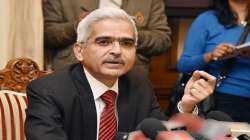Room for more rate cuts as govt hands tied, inflation under check & slump deepens, says RBI Governor
However, the governor was quick to add that there is little fiscal space for the government to unveil any countercyclical measures to boost the sagging growth and the only way to revive the growth engine is to front-load the budgeted capex, hinting that only an easy money policy can help salvage the situation.

After surprising everyone with four successive rate cuts this year, Reserve Bank governor Shaktikanta Das Thursday said "there is more room" to do so given the growth deceleration and stable inflation that is likely to stay below target for a year or so.
However, the governor was quick to add that there is little fiscal space for the government to unveil any countercyclical measures to boost the sagging growth and the only way to revive the growth engine is to front-load the budgeted capex, hinting that only an easy money policy can help salvage the situation.
Since assuming charge mid-December, the Das-led rate- setting panel has delivered four successive rates cuts, with the fourth one last month being the most surprising and unconventional one as he chose to deliver a 35 bps repo cut.
With that the RBI has delivered a cumulative 110 bps repo reduction since February, yanking down the key benchmark rate to a nine-year low of 5.40 percent.
"When we see that the price stability is maintained and inflation is much below the 4-percent mandate and is expected to be so in the next 12 months horizon, there's a room for more rate cuts especially when growth has slowed down," Das told Bloomberg India economic summit this evening.
On the shrill calls from industry for fiscal measures in the form of tax cuts, Das said, "the government must front-load the budgeted spending as it has t little fiscal space for any countercyclical measures to boost growth."
Stating that there is little space for fiscal expansion, Das said, "so far as the fiscal side is concerned, the government has by and large remained prudent. They have
not announced any countercyclical measures that would have lead to fiscal expansion. Most of these things announced are non-fiscal.
"I think the fiscal space is itself very limited. Fiscal deficit at 3.3 percent borrowings by PSUs both put together there is very little space. But what is the internal position of the govt with regard to tax collection, how much expenditure is likely to be materialised, that is something the govt has to view," Das said.
Indicating deepening crisis in the economy, which is partly cyclical and more structural, the government had more bad news pouring in in recent days.
While advance tax mop-up missed the target by a wide margin inching up by a paltry 4.7 percent in for the first half against a target of 17.5 percent at Rs 5.50 lakh crore up from Rs 5.25 lakh crore a year-ago.
The first quarter GDP slowed to a six-year low of 5 percent and last month for the first time exports degrew.
Every industry, be it auto or FMCG, is gasping for breath as consumer demand has slumped.
That tax revenue was not robust was clear when the government said it had used up as much as 77 percent of the fiscal deficit or market borrowing by July end.
The July budget had set a direct tax mop-up target of 17.5 percent for the full year, while the same for indirect taxes are set at 15 percent.
"Total advance tax collection in the first half stood at Rs 5.5 lakh crore compared to Rs 5.25 lakh crore in the same period last year, a growth of just 4.7 percent, a senior tax official had told PTI Wednesday.
ALSO READ: India certain to become $5 trillion economy by 2024: Amit Shah
ALSO READ: Government mulling another booster dose to reinvigorate economy